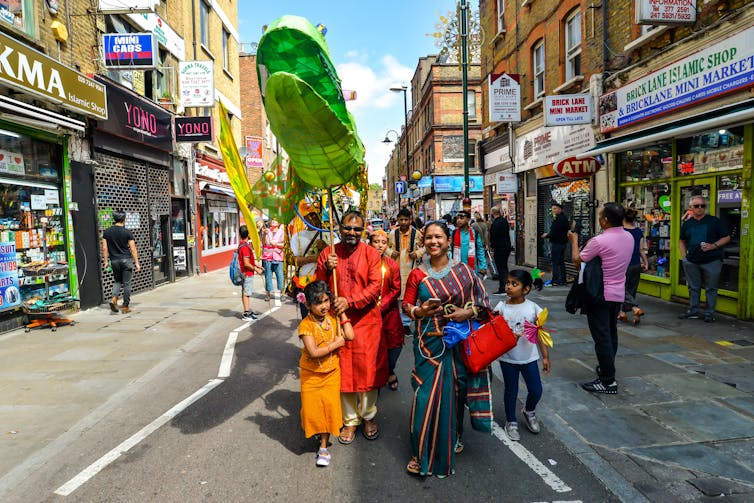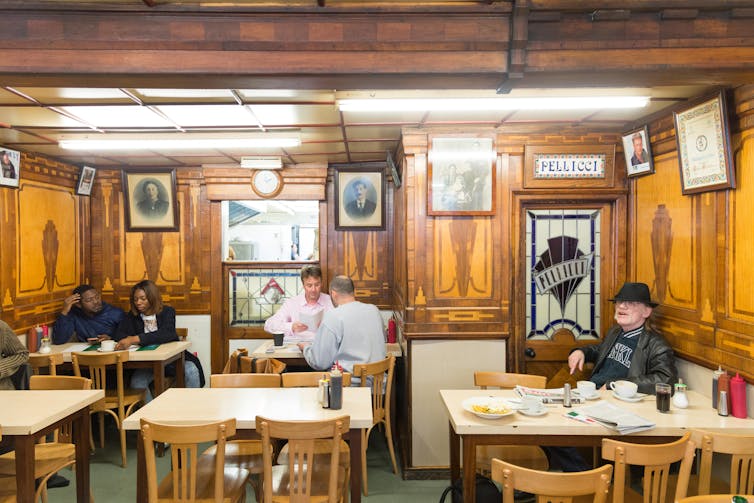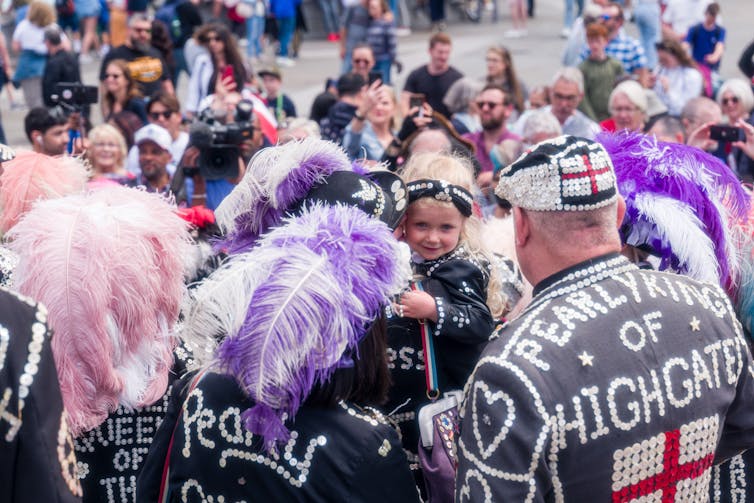In response to a community petition, Tower Hamlets council in east London has designated Cockney as a “community language”. This recognition paves the way for the borough to actively challenge the linguistic discrimination that speakers of “non-standard” English dialects face.
Research in 2023 found that young people in the south-east of England no longer speak the variety of English we think of as “Cockney”. This has led some pundits to decry what they understand to be the death of this longstanding dialect.
Cockney has long been held, in the public imagination, as a criminal code of rhyming slang that emerged among Londoners born in the sound of Bow bells. This is historically inaccurate.
Our new report identifies – and challenges – the discriminatory, anti-working-class ideologies that underlie myths about Cockney and other non-standard varieties of English Englishes.
Tennessee Jones|Alamy
Cockney was originally posh
The earliest citation of Cockney dates back to the 1390s. In his medieval poem, Piers Plowman, writes: “And I sigge, bi my soule, I haue no salt Bacon, Ne no Cokeneyes”. A “Cockeneye” was an imaginary “cock’s egg” – the speaker is saying he had nothing to eat, not even imaginary food.
Early written uses of Cockney to describe people capitalised on an egg’s delicate and embryonic qualities. When Chaucer wrote “Cokenay” in the Canterbury Tales he meant, “a spoilt or pampered child”.
Even as late as 1904, “Cockney” was used to mean, “a feeble and pampered person from a city”. The word reflected the perception that city life was luxurious compared with toiling on England’s farms.
Because London is the prototypical English city, “Cockney” came to be used as a label for Londoners. The famous definition of the dialect as hinging on being born within earshot of Bow bells is attributed to a 1571 sermon by J. Bridges, in which he wrote: “We are thorough out all the Realme called cockneys that are borne in London, or in the sounde of Bow bell.”
Bridges meant that people throughout England called Londoners “Cockneys”. In the 16th century, the St Mary-le-Bow church was indeed a symbol for London, not a tool for distinguishing this one part of the city from the rest of it. All Londoners were Cockneys.

Alena Veasey|Shutterstock
Recasting Cockney as a working-class English
Studies of language change in large cities often show that linguistic innovations emerge in working-class communities and then spread. It is likely that, in past centuries, east London working-class communities would have been drivers of innovations for the varieties of English spoken in the capital.
In the 1700s and 1800s, the emergence of the middle-class lifestyle as a target for upward mobility gave rise to a self-help industry for attaining higher social status. Along with prescriptions for how to dress and how to eat a meal, adopting “proper speech” became a target for ascending to the middle class.
Elocutionists sold books by picking out innovative features of London English and inveighing against using them. They recast the label “Cockney” as a working-class English that people should avoid if they wanted to sound properly middle class.
In the 19th century, authors including Charles Dickens followed the elocutionists. They assigned Cockney linguistic features to working-class (and often nefarious) characters. These characterisations reinforced the conceptualisation of Cockney as a working-class (and criminal) language.

Olivier Guiberteau|Shutterstock
Changing enregisterment
What changed over more than 600 years, then, was the way Cockney was, as linguists put it, “enregistered”. Enregisterment is the process of linguistic features becoming linked in popular consciousness to a group or place.
By the 1700s, Cockney was enregistered as “London English”. The leading edge of London English would have been the speech of working-class east London communities. Through the 1800s, intellectuals profited from stigmatising working-class linguistic features. This narrowed the enregisterment of Cockney to “working-class London English”.
Our modern understanding of Cockney is based on this recent re-enregisterment. It conceptualises Cockney as a specific set of linguistic features, associated with negative social characteristics and constrained to working-class east London.
This is reflected in popular explanations for rhyming slang as a definitive feature of the dialect. Rhyming slang emerged in Cockney relatively recently, probably in the late 1800s and early 1900s.
Contrary to popular belief, rhyming slang never could have been a way to obscure criminal activity from police. After all, code words only work until another person learns them. (Consider that today, street cops know the vocabulary for the crimes they encounter.)
The idea that Cockney rhyming slang encoded criminality is predicated on the ideology that working-class people engage in criminal activity. Within this logic, it follows that if working-class people are talking about something, it must be crime.

Alex Segre|Alamy
Today, working-class east London communities continue to be a driving force behind linguistic innovations that are spreading throughout England. This kind of innovation is still stigmatised. Speakers who use them are routinely penalised in gatekeeping settings such as school and media and in hiring decisions.
Some people we have spoken as part of our research identify, specifically, as Cockney. Others claim an affinity with the personal resilience and community-mindedness that have long been central to the Cockney identity.
Further, we have found that Cockney is not a reductive, monolithic identity, but rather a multifaceted one. We have interviewed Londoners who identify as Bengali Cockney, Black Cockney, East End Cockney, Essex Cockney, Jewish Cockney and Sylheti Cockney, among others.
Linguists speak about “codeswitching” to refer to people shifting from non-standard to standard English for socioeconomic attainment. This practice illustrates how judging someone’s speech as “non-standard” is always ideologically driven.
Tower Hamlets’ recognition of Cockney as a “community language”, by contrast, acknowledges the linguistic validity of all varieties of English spoken in the borough. It celebrates the role that non-standard dialects play in shaping individual and community identities and the ways in which identities such as “Cockney” continue to evolve. As one of our interviewees (all of whom are anonymised in our report) put it:
[Cockney] is a manifestation of working-class culture. That’s how it feels, a kind of positive working-class culture, which is under the cosh. To have vibrant working-class culture is something that is absolutely valuable.




